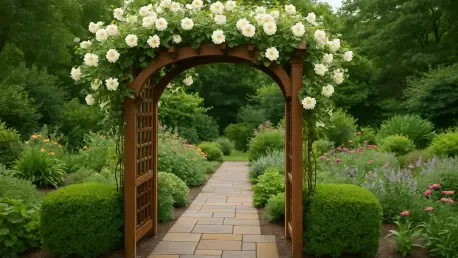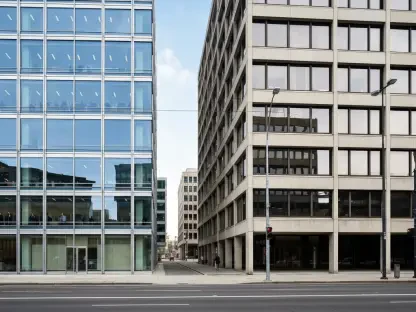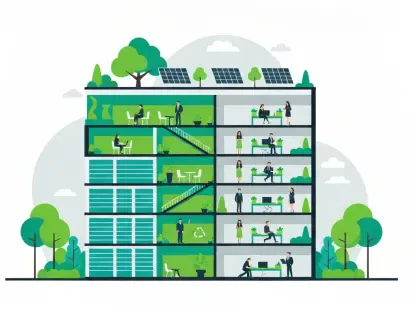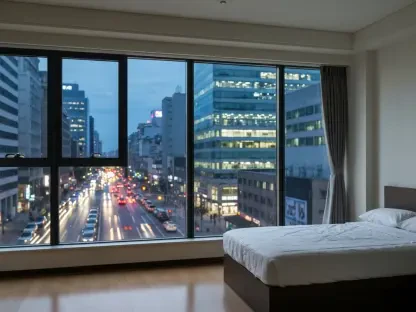Imagine stepping into a backyard that feels like an extension of the home, where a beautifully crafted structure adorned with climbing roses or vines welcomes visitors into a serene garden space, instantly creating a sense of tranquility and charm. This captivating vision is becoming a reality for many homeowners as garden arbors, once considered a relic of vintage landscaping, are experiencing a remarkable resurgence in modern outdoor design. These elegant entryways, defined by their sturdy posts and slatted roofs, are capturing attention for their ability to blend functionality with aesthetic charm. Far from being mere decorations, arbors serve as symbolic gateways to outdoor sanctuaries while supporting lush greenery and enhancing the ambiance of any yard. This revival taps into a broader cultural shift toward creating seamless indoor-outdoor living environments, a trend that has gained significant traction in recent years. As more people seek to transform their gardens into functional and inviting spaces for relaxation and entertainment, arbors are emerging as a timeless solution that marries nostalgia with contemporary style.
Reviving a Vintage Trend for Modern Living
Garden arbors are redefining outdoor spaces by offering a perfect blend of historical allure and practical application, aligning with the growing desire to extend living areas beyond the confines of indoor walls. These structures, often seen as quaint reminders of bygone eras, have found new relevance in today’s landscape design, particularly as homeowners prioritize al fresco dining areas and cozy retreats for unwinding. The appeal lies in their versatility—arbors not only act as striking focal points but also provide frameworks for climbing plants like wisteria or clematis, creating natural canopies that offer shade and beauty. Designers have noted a surge in interest for elements that evoke a sense of warmth and comfort, mirroring interior trends that favor lived-in, nostalgic aesthetics. This connection between indoor charm and outdoor functionality underscores why arbors are becoming a go-to choice for those looking to craft gardens that feel like an integral part of the home, seamlessly bridging the gap between personal style and nature.
The resurgence of arbors also reflects a deeper cultural movement toward valuing open spaces that foster connection and relaxation, especially in the wake of heightened focus on outdoor living. Landscape experts highlight how these structures resonate with the popular cottage garden style, characterized by its naturalistic and inviting vibe, which complements modern architectural sensibilities. Beyond their visual appeal, arbors contribute to a garden’s ambiance by supporting features like hanging lights or draped fabrics, transforming ordinary yards into enchanting escapes for evening gatherings. Their ability to define spaces—marking transitions from one garden area to another—adds a layer of intentionality to landscape design. As more homeowners seek to personalize their outdoor environments, arbors stand out as a customizable option that can be tailored to match a home’s unique character, ensuring that the garden becomes a true reflection of individual taste while enhancing the overall livability of the property.
Practical Benefits and Design Synergy
One of the standout reasons behind the renewed popularity of garden arbors is their dual role as both decorative elements and functional additions to any outdoor space, offering shelter and structure in equal measure. When covered with lush vines or fragrant roses, these frameworks create a natural canopy that provides shade during hot summer days, making gardens more usable and enjoyable throughout the seasons. This practical advantage is often cited by landscape professionals as a key factor driving their comeback, as arbors meet the demand for spaces that are not only beautiful but also purposeful. Additionally, their design can be adapted to suit various garden sizes and styles, from sprawling estates to compact urban yards, ensuring accessibility for a wide range of homeowners. The integration of such structures into modern landscapes speaks to a collective yearning for environments that feel both curated and cozy, echoing vintage design principles while serving contemporary needs with ease.
Beyond functionality, the successful incorporation of arbors hinges on their ability to harmonize with a home’s existing architecture and the surrounding natural elements, creating a cohesive outdoor aesthetic. Experts emphasize the importance of selecting materials and colors that complement the property’s facade, whether it’s rustic wood for a farmhouse vibe or sleek metal for a minimalist look. The spacing of slats and the height of the structure must also be considered to accommodate the specific growth habits of chosen plants, ensuring long-term durability and visual balance. For instance, heavier climbers require robust frames, while lighter varieties can thrive on more delicate designs. This thoughtful alignment of form and function is what elevates arbors from mere garden accessories to integral components of a well-designed yard. By blending seamlessly with both the built environment and the organic landscape, arbors help craft outdoor spaces that feel intentional and polished, enhancing the overall appeal of the home.
Timeless Tips for Seamless Installation
For homeowners eager to embrace this vintage trend, careful planning is essential to ensure that garden arbors not only enhance visual appeal but also stand the test of time in diverse outdoor conditions. A critical first step is selecting the right type of climbing plants, as their weight and growth patterns directly impact the arbor’s structural requirements. Heavy vines like wisteria demand sturdy, reinforced frames, whereas lighter options such as clematis can flourish on less robust designs. Equally important is determining the ideal location within the garden, considering factors like sunlight exposure and proximity to other landscape features to maximize both aesthetic and functional benefits. Consulting with landscape designers can provide valuable insights into creating a balanced look that integrates the arbor with pathways or seating areas. By prioritizing these elements during the planning phase, the resulting structure can serve as an enduring centerpiece that elevates the garden’s charm and usability for years to come.
Another vital aspect of installing garden arbors lies in customizing their design to reflect the home’s architectural style while ensuring sustainability within the local ecosystem. Materials should be chosen not only for their durability against weather elements but also for their ability to blend with the surrounding environment, using complementary tones and textures for a unified appearance. Experts also advise considering the spacing between slats to allow adequate light and air circulation for plant health, preventing issues like mold or stunted growth over time. Additionally, aligning the arbor’s proportions with the scale of the garden prevents it from overwhelming smaller spaces or appearing underwhelming in larger ones. This tailored approach ensures that the structure enhances rather than detracts from the overall landscape. With mindful attention to these details, homeowners can create an outdoor feature that feels both timeless and uniquely personal, adding lasting value to their property.
Reflecting on a Lasting Legacy
Looking back, the revival of garden arbors captured a pivotal moment in outdoor design, where nostalgia intertwined with practicality to reshape how spaces were envisioned and utilized. These structures stood as more than mere adornments; they became symbols of a collective desire for connection, comfort, and beauty in everyday surroundings. Their ability to transform gardens into inviting extensions of the home resonated deeply with homeowners who sought refuge and inspiration in nature. As landscape designers championed their versatility, arbors cemented their place as cherished elements that bridged past traditions with modern aspirations. Moving forward, the focus should shift to innovative adaptations—exploring sustainable materials or integrating smart lighting solutions to enhance functionality. Encouraging experimentation with diverse plant pairings or modular designs could further personalize these frameworks, ensuring they remain relevant. Ultimately, the enduring charm of arbors lies in their capacity to evolve, inviting future generations to reimagine outdoor spaces with creativity and purpose.









